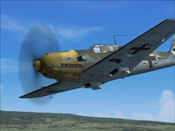Without a doubt, the Messerschmitt Bf 109 was Germany's most important, and most numerous, fighter of World War II. With more than 30,000 of all variants produced, it is easily the most numerous of any fighter type of the war. First flown in 1935 as the Bf 109a, this arch-enemy of Great Britain was fitted with, of all things, a Rolls-Royce engine. It did not meet with instantaneous enthusiasm from pilots used to open cockpits, two wings, and great low-speed agility such as the biplanes of World War I. However, it was ultimately ordered into production and in time, developed into the superior E-4, when the DB 601 engine was finally available in quantity.
The "Emil" was a fine aircraft and served well on the front lines through the middle of 1940, when its limitations became more obvious. The most glaring problem was range. In addition, while the top speed of the aircraft was identical to the Spitfire Mk I against which it was matched, it did not dive well and suffered from poor fuel economy due to its rather cobbled-together design. The underwing radiators added considerable drag, and the controls tended to feel as though they were embedded in cement after about 400 mph indicated airspeed. The Emil had a good deal of trouble pulling out of a fast dive, and more than one Bf 109E pilot was killed trying to follow a Spitfire in a dive. The elevator simply would not provide enough force at high speed to pull out if the pilot waited until he was too close to the ground.
Despite these shortcomings, the plane had strengths that could be exploited. The direct fuel injection meant the engine would never cut out due to negative g-forces, as would the Hurricanes with their gravity carburetors. The plane was quite agile at low and medium speeds and had well-harmonized controls up to about 300 mph indicated airspeed. The automatic leading edge slats did have their advantages in a tight turn, although the Spitfires, with their much greater wing area, could still turn inside the Bf 109 without any problem.
A well-flown Bf 109 E, regardless of its warts, was always a worthy competitor for a Spitfire Mk IA, and was a better plane than the Hurricane in many respects. However, in the end, the plane was not developed quickly enough and it was the Focke-Wulf 190 to which the torch was passed in the spring of 1941. By that time, the Battle of Britain was over and a different kind of war had begun, this time over the European mainland.
The Bf 109 was developed into several more refined variations, with the Bf 109G perhaps being the best overall of the bunch. But the Bf 109 E is the one that most World War II aficionados will recognize because of its prominent role in the Battle of Britain. It truly was one of the seminal fighters of World War II, and no collection of the best fighters of the early war would be complete without it.
FEATURES
- Unsurpassed attention to detail
- Can be flown “by the book”
- Gorgeously constructed aircraft, inside and out, down to the last rivet
- Fully clickable cockpits with authentic working gauges
- The latest wind-tunnel technology helps to create the most authentic,fluid flying qualities, including complex spins and stalls
- Enhanced visual effects and lighting
|

